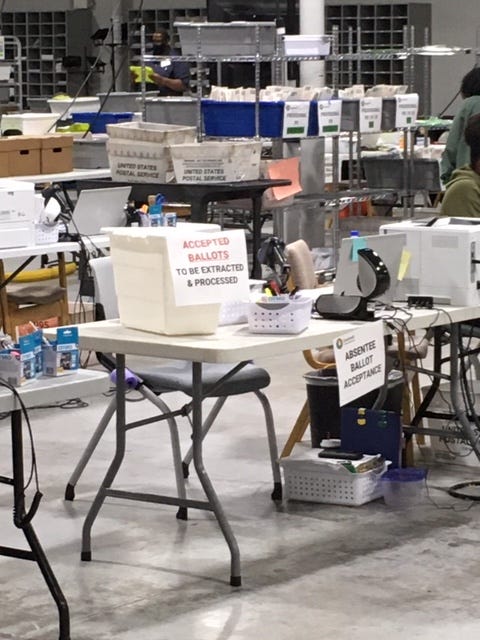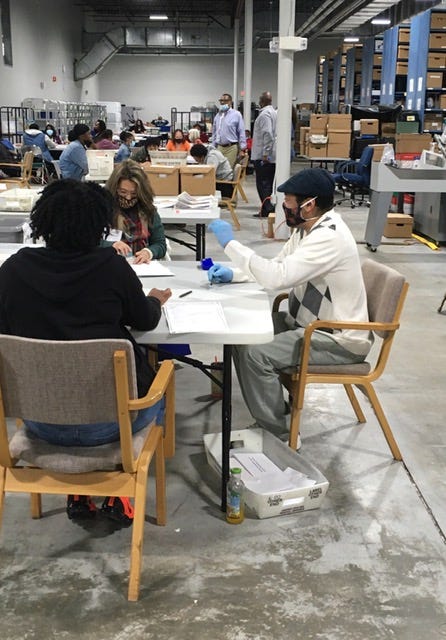
Drew Angerer/Getty Images
- A peek behind the scenes in Gwinnett County, Georgia, shows how the vote tallies make their way to TV, laptop, and cellphone screens, keeping millions in suspense.
- Early Friday morning, tallies from Clayton County tipped the state blue in favor of President-elect Joe Biden, but the state has not been called.
- On Friday, votes were still being tallied in the state’s second-largest county — and one of its most diverse. Here’s what it looked like behind the scenes.
- Visit Business Insider’s homepage for more stories.
LAWRENCEVILLE, GEORGIA – With what appeared to be the largest amount of votes still uncounted and not uploaded to the Georgia Secretary of State’s website, nerves were fraying Friday mid-afternoon at the Gwinnett County Voter Registrations and Elections office.
Election integrity activists and analysts were wondering on Twitter: where were Gwinnett’s votes?

Timothy Pratt
Georgia’s second-largest county, with nearly a million residents, more than half of whom are Black and brown, had not updated vote tallies since Wednesday at 1:21 a.m. local time. Every other population center in the state had made ongoing updates. The county’s diverse, Democratic-leaning electorate had already shown its importance, outpacing the rest of the state in early voter turnout when compared to 2016. And early Friday morning, votes from Clayton County, which includes former Rep. John Lewis’ district, had flipped the race, bringing Joseph Biden above President Donald Trump by a little over a thousand votes.

Timothy Pratt
This made the nearly 7,000 outstanding ballots in Gwinnett even more important, as the nation continued to wait for tallies from a handful of states, including Georgia. While Insider and Decision Desk HQ called the presidency for Biden, after projecting him as the winner in Pennsylvania, Georgia has not yet been called for either candidate, though Biden leads. A Georgia win would broaden his lead and mark a historic shift: the first time the state had voted for a Democratic presidential candidate since 1992.
At around 2:30 p.m. on Friday, Elections Supervisor Kristi Royston asked a small group of vote adjudication panelists – whose job it is to decide on voter intent when they haven’t clearly marked absentee, mail-in ballots – to take a break for at least an hour, because another batch of votes needed to be tallied in the next room, and the two processes couldn’t take place at the same time. When asked why, board member Stephen Day, who was about to serve on an adjudicating panel, said he had “the same question.”
Then Kristen Burton, a volunteer for the state Democratic Party's voter protection effort, approached Royston to point out that one panel of adjudicators was lacking someone from her party. Each panel must have an adjudicator from each party, plus a neutral member. After a bit of back and forth about changes to the adjudication schedule in the previous two days, Royston snapped, "This isn't the only thing I've had to pay attention to."
A peek behind the scenes into what Royston has been paying attention to shows how the vote tallies make their way to TV, laptop, and cellphone screens, keeping millions in suspense – and how much some states are beholden to voting machine manufacturers. (Georgia became the only state in the country last year to overhaul its entire election system, paying Denver-based Dominion Voting Systems $106 million for new voting machines, printers and scanners.) In a matter of days, the county had gone from feeling "so proud" after processing most of its 120,000-plus absentee mail-in ballots in the previous weeks, to finding "a problem" when it came to tabulating about 3,000 adjudicated ballots on Election Day, said Joe Sorenson, the county spokesman.

Timothy Pratt
"We had to get the senior techs [from Dominion] on the phone," Sorenson said. After talking to them, the county convened an emergency Board of Registrations and Elections meeting; the board voted unanimously to follow their advice and adjudicate the ballots once again.
The process took two days – until Thursday night at 10 p.m. local time. And what's worse, Gwinnett couldn't upload several other groups of ballots until the job was done, including another group of thousands of absentee mail-in ballots; nearly a thousand provisional ballots – which are used in cases such as voters showing up at the wrong polling site – and about 460 votes from a voting machine with a "corrupted memory card," resulting in the votes being lost in the system, and then found again by tracing them through the paper ballots each machine prints out.
So in the end, a problem on Election Day resulted in thousands of votes not being uploaded until Friday, 4:57 p.m. local time. "We wish it never had to be done," Sorenson said. "We continue to talk to Dominion" about the cause of the problem, he added. It was not the only case in which Georgia local elections officials were left helpless in the face of "technical difficulties." In rural Spalding and Morgan Counties, two rural counties with a combined population of around 85,000, voting machines stopped working for several hours on Election Day.
Meanwhile, about 100 staffers sat at folding tables in a cavernous room at the rear of the Gwinnett County office throughout the day and into the evening Friday, going through provisional and other ballots. None of the officials Business Insider spoke with, including Sorenson, could say how many ballots remained. Asked about the Secretary of State's estimates for remaining votes coming out of Gwinnett, he said, "I can't even speculate on the numbers they're giving."

Timothy Pratt
The county finally uploaded 6,883 ballots early evening, which, together with ballots from smaller counties, widened Biden's lead to about 4,000 votes. Later on, around 9:45 p.m. local time, the few remaining observers included Harri Hursti, an election cybersecurity expert who has studied elections in five countries, including the US, and has been featured in several documentaries on the subject. As he observed three men at computers on the other side of a window, he noted, "they've just received an error notice." Within minutes, the three men shut off the computers and left for the night.
A conversation ensued about other issues with the county's system, including when they had to pause the adjudication earlier because votes needed to be uploaded. Hursti explained how the system's design made it so working on one chore – uploading votes – would make it impossible to do another chore at the same time – entering data on adjudicated ballots into the system, due to outdated software.
"The problem," said Hursti, "is this system has not been designed in this decade or even the decade before."
